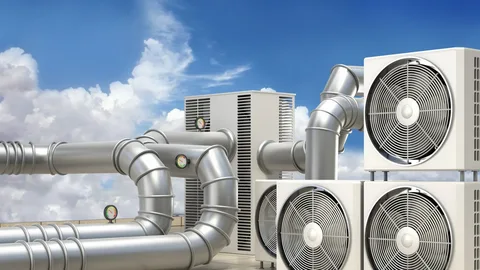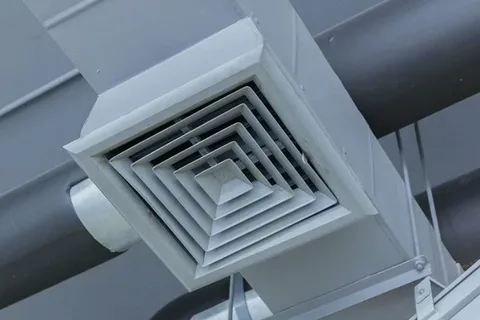Are you looking to improve the quality of air in your home whilst also enhancing your overall quality of life? If so, investing in a ventilation system could be the solution you’ve been searching for. A ventilation system can help to circulate fresh air, remove pollutants, control humidity levels, and ultimately create a healthier and more comfortable living environment for you and your family. In this blog post, we will explore the various ways in which a ventilation system can improve your quality of life, from enhancing indoor air quality to reducing humidity and preventing mould growth.
Understanding the Basics of a Ventilation System
At its core, a ventilation system is engineered to facilitate the exchange of air within a space to maintain a high standard of indoor air quality. This exchange involves the removal of stale, contaminated air from inside and the introduction of fresh, clean air from the outside. Various configurations exist to achieve this, including exhaust, supply, and balanced systems, each tailored to address specific requirements.
Exhaust systems focus on expelling indoor air to the outside, supply systems work by drawing fresh air into a building, and balanced systems combine both actions to maintain an equilibrium in air quality and temperature. The choice between these systems depends on numerous factors, including the architectural design of the property, the local climate, and individual health concerns. Understanding these systems’ operational principles is pivotal for selecting the most suitable option that aligns with your needs, ensuring that your home remains a sanctuary of clean, breathable air.
Enhancing Indoor Air Quality with Ventilation
A pivotal advantage of a ventilation system lies in its capacity to significantly improve indoor air quality. Exposure to substandard air within our homes can instigate or exacerbate health conditions such as asthma, allergies, and other respiratory complications. Ventilation systems adeptly mitigate this risk by facilitating the continuous movement of air, ensuring the expulsion of contaminants like dust mites, pollen, and pet dander which are commonplace in domestic environments.
This dynamic process of air exchange not only purifies the air but also safeguards the well-being of occupants by minimising their exposure to potential allergens and irritants. The introduction of fresh, clean air through a ventilation system is instrumental in fostering a healthier and more salubrious living space, directly contributing to the enhancement of indoor air quality and, by extension, the health and comfort of residents.
Reducing Humidity and Preventing Mould Growth
A well-implemented ventilation system is pivotal in maintaining optimal levels of humidity within your home, thus circumventing the conditions that favour the proliferation of mould and mildew. These fungi not only pose a risk to your health, manifesting in allergies and respiratory issues, but also to the fabric of your dwelling, compromising its structural integrity over time. By judiciously expelling moist air and introducing a stream of drier air, a ventilation system adeptly addresses the core of the humidity challenge.
This dynamic process effectively thwarts the dampness that mould spores thrive on, safeguarding your living spaces from their insidious growth. Beyond health and structural benefits, managing humidity through proper ventilation also contributes to the preservation of your belongings, including furniture and electronics, which can suffer in excessively damp conditions. The role of a ventilation system in this regard is not merely about enhancing comfort but about providing a holistic approach to maintaining a healthy, mould-free environment. This proactive measure ensures your home remains a safe haven, free from the clutches of damp and mould.
Energy Efficiency of Energy Recovery Ventilator
An Energy recovery ventilator (ERV) offers a sophisticated approach to maintaining a comfortable indoor climate whilst significantly enhancing energy efficiency within the home. These systems ingeniously capture the thermal energy from outgoing stale air and transfer it to the incoming fresh air. During colder months, the warmth from the extracted indoor air is used to pre-heat the fresh, colder air from outside before it enters the living space.
Conversely, in warmer conditions, the system extracts heat from the incoming air and transfers it to the outgoing air, reducing the cooling demands on the home’s air conditioning system. This process not only ensures a steady supply of fresh air but also minimises the energy required to heat or cool the home, reflecting directly in lower energy bills and a reduced environmental footprint.
The operation of an ERV is a testament to the advancements in ventilation technology that prioritise both environmental sustainability and homeowner comfort. By leveraging the thermal properties of exchanged air, ERVs present a compelling solution for those seeking to optimise their home’s energy utilisation without compromising on indoor air quality or thermal comfort. This energy-saving mechanism underscores the ERV’s role as a pivotal component in modern, energy-efficient home design strategies.
 Creating a Comfortable Living Environment
Creating a Comfortable Living Environment
A ventilation system plays a crucial role in not just maintaining the healthfulness of your indoor air but also in ensuring your living spaces remain a haven of comfort. By facilitating the movement of fresh air throughout your home, it effectively addresses issues of stuffiness and uneven temperatures that can detract from your living environment’s appeal.
The presence of a well-designed ventilation system means that unwanted odours, whether from cooking, pets, or other domestic activities, are quickly dispelled, replaced by clean, oxygen-rich air. This continuous renewal of air also helps in maintaining an ambient indoor temperature, making your home feel more inviting throughout the year. The benefits extend to sound levels as well; modern ventilation systems operate with such quiet efficiency that the peace of your home is undisturbed, enhancing the sense of tranquillity. This aspect is particularly valuable in creating spaces where relaxation and unwinding are key, free from the distraction of external noises.
Furthermore, the strategic introduction of fresh air can aid in the natural regulation of room temperatures, contributing to a living environment that adapts seamlessly to your comfort needs without the constant recourse to heating or cooling systems. This synergy between fresh air circulation and temperature control underscores the pivotal role of a ventilation system in elevating the comfort and enjoyment of your home.
Ventilation Systems and Your Health
The impact of indoor air quality on our physical health is undeniable. With the increasing concerns about the levels of pollution and allergens within our homes, a ventilation system becomes not just a beneficial addition but a necessity. These systems are intricately designed to filter out harmful pollutants, such as volatile organic compounds (VOCs) emitted from paints, furniture, and cleaning products, as well as allergens like pollen and pet dander.
By ensuring a continuous supply of fresh air, ventilation systems significantly reduce the risk of respiratory conditions, enhance lung health, and aid in the prevention of allergy symptoms. They are particularly beneficial for individuals suffering from asthma or other respiratory issues, as they help in creating an environment that supports respiratory health. Equally important is the role of these systems in diluting and removing airborne pathogens, potentially lowering the spread of illnesses within a home.
This aspect of ventilation is crucial in maintaining not just the physical health but also the peace of mind of occupants, knowing their living environment supports their wellbeing. Engaging with a ventilation solution is, therefore, an investment in a healthier lifestyle, offering protection against a range of health risks associated with poor indoor air quality.
Choosing the Right Mechanical Ventilation System for Your Home
Selecting an appropriate mechanical ventilation system for your dwelling requires careful consideration of several key factors.
Architectural Layout of Property
These include the architectural layout of your property, the climatic conditions prevalent in your region, and the specific health needs of your household members. For instance, homes in more humid climates might benefit more from systems that excel in moisture control, whereas those in urban areas might prioritise systems with superior air filtration capabilities to combat pollution.
Size of Residence
The size of your residence plays a critical role, as larger homes might necessitate more complex systems to ensure efficient air circulation in all areas. Additionally, the lifestyle and activities of the occupants — whether it involves cooking frequently, owning pets, or engaging in hobbies that might affect indoor air quality — should guide the choice of system. Budget considerations are also paramount, not only regarding the initial outlay for the system itself but also the long-term operating costs, including maintenance and energy consumption.
Engagement with Professional
Engagement with a professional in the heating, ventilation, and air conditioning (HVAC) field is invaluable in navigating these considerations. A qualified technician can offer insights into the most suitable types of systems for your unique scenario, balancing efficiency with functionality. They can also guide you through the latest technological advancements in ventilation systems, ensuring you make an informed decision that aligns with both your immediate needs and future aspirations for a healthy, comfortable home environment.
Maintaining Optimal Humidity Levels in Your Home
Achieving the right balance of humidity within your residence is pivotal for fostering a comfortable and health-promoting environment. Too much moisture in the air can encourage the growth of mould and dust mites, whilst air that’s too dry may lead to dryness in the skin, eyes, and airways. A well-configured ventilation system adeptly manages this balance, extracting excess moisture when humidity levels climb too high, especially during warmer months, and introducing moisture-laden air as needed in drier conditions.
This regulation of indoor humidity not only protects the structure of your home from damp-related damage but also ensures that your indoor environment remains conducive to well-being, alleviating symptoms associated with improper humidity levels. By keeping indoor air at an optimal humidity, the system supports a living space that is not just comfortable but also conducive to maintaining the health of its inhabitants and the integrity of the building itself.
Conclusion
In summary, the introduction of a ventilation system into your home represents a proactive step towards ensuring a healthier, more comfortable, and energy-efficient living environment. From significantly improving indoor air quality to managing humidity levels, preventing mould growth, and enhancing energy conservation through energy-recovery ventilators, the benefits are multifaceted. Each aspect of ventilation, be it for health benefits, structural integrity of your home, or the comfort it brings to daily living, underlines the importance of making an informed choice.
FAQs
Q: What’s the recommended frequency for replacing filters in my ventilation system to maintain optimal air quality?
A: To ensure your ventilation system operates efficiently and continues to improve indoor air quality, it’s advisable to replace the filters approximately every three to six months. This timeframe can vary based on the specific recommendations provided by the manufacturer and may also depend on factors such as the usage intensity and the presence of pets or high levels of pollutants.
Q: Can installing an energy recovery ventilator alleviate the presence of cooking smells throughout my home?
A: Absolutely, a well-designed energy recovery ventilator is highly effective at eliminating cooking odours. By expelling the stale, odorous air and drawing in fresh, clean air from outside, it prevents these smells from lingering and permeating your living spaces, thus maintaining a pleasant indoor atmosphere.
Q: Is it necessary to engage a professional for the installation of a home ventilation system, or can it be a DIY project?
A: For optimal performance and safety, it is strongly recommended to enlist the services of a professional HVAC technician for the installation of your ventilation system. Their expertise ensures the system is correctly configured to your home’s specific requirements, guaranteeing efficient operation and avoiding potential issues that could arise from incorrect installation.
| Related Business Listings |
| Contact Directory |
| Local Business Profiles |
| Other Good Articles to Read |
| Blogs-Nation |
| Blogs-Peoples |
| Bryan Smith Blogs |
| Intellect Blogs |
| The Fault In Our Blogs |
| Blogs Eu |
| Oz Forums |
| Recruitment Blogs |
| Zet Blogs |
| Id Blogs |
| Blogs Tudiolegale |

